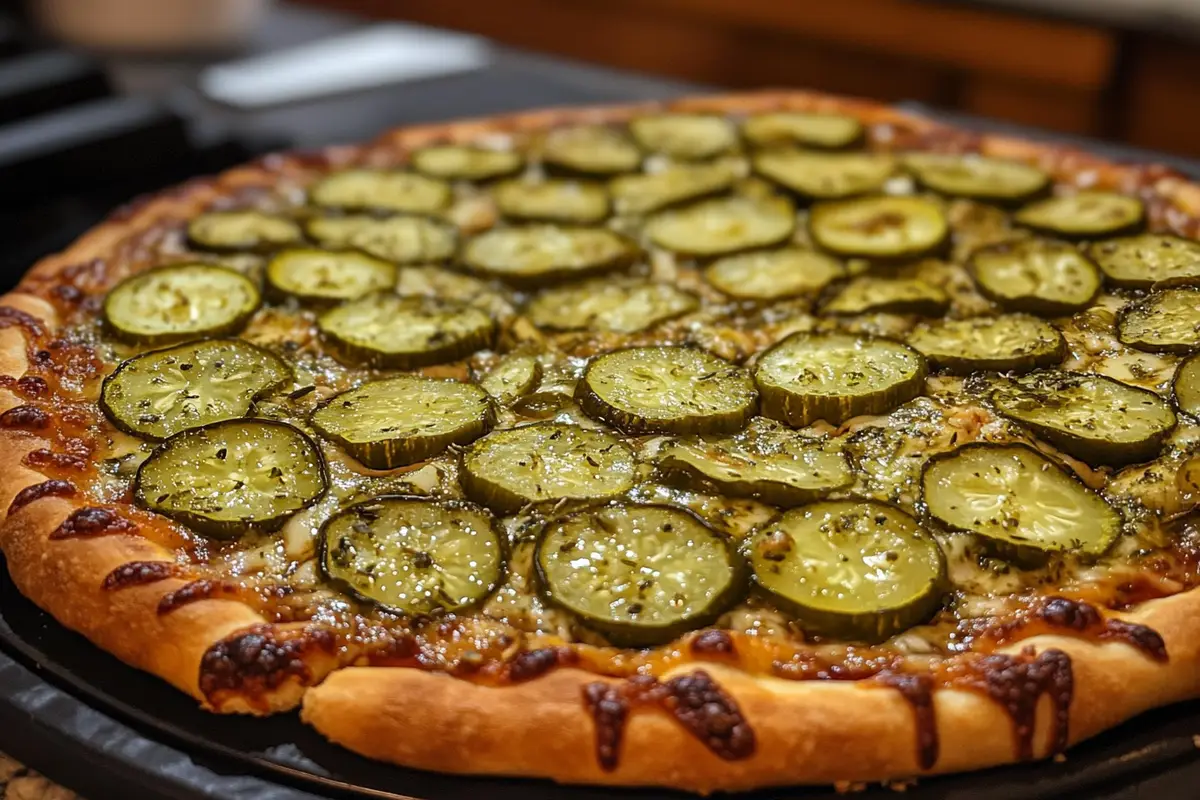Introduction to Pickle Pie Pizza
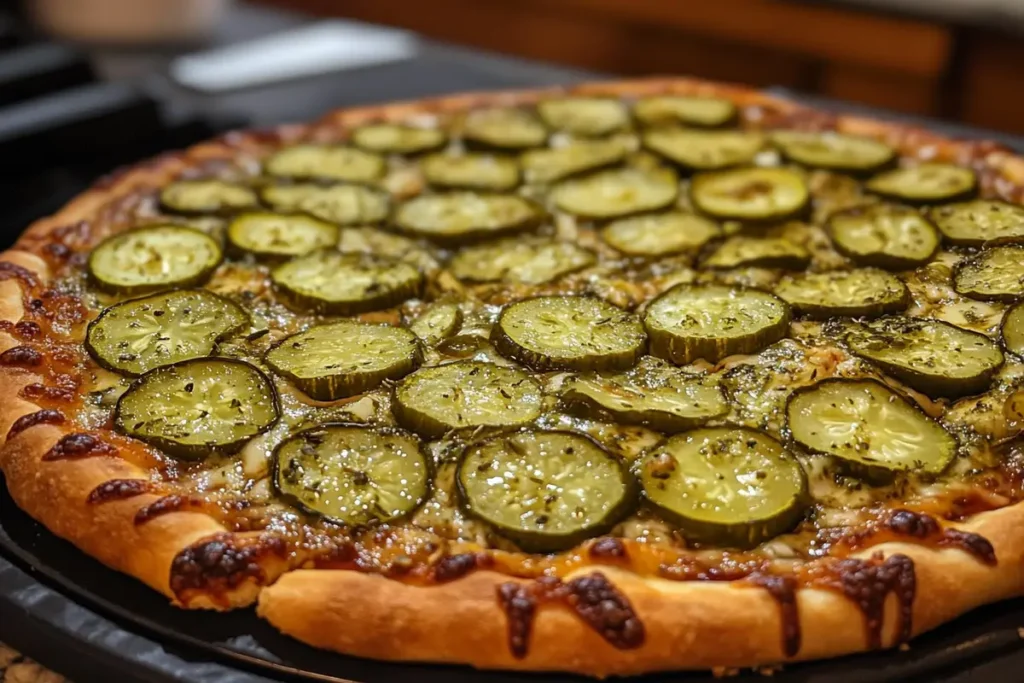
The Emergence of Pickle Pie Pizza
Pickle pie pizza is no ordinary pizza. It’s a playful twist on a classic dish that combines comfort food with the bold zing of pickles. But where did this idea come from? Its origins trace back to creative chefs experimenting with pickles as toppings, and since then, it’s become a favorite among food enthusiasts who love a balance of tangy and savory flavors.
Interestingly, pickle pizza gained even more attention through social media platforms, food festivals, and even national chains adding it to their menus. This unique culinary creation quickly became a hit, particularly in regions where pickles are deeply loved as side dishes or snacks.
What is Pickle Pie Pizza?
Simply put, pickle pie pizza is a savory pizza topped with thinly sliced dill pickles, garlic-infused sauces, creamy cheeses, and sometimes extra seasonings to bring out a punchy flavor.
Key Ingredients
The foundation of a great pickle pie pizza includes a thin crust, a base sauce like ranch or garlic spread, and, of course, high-quality pickles. Dill pickles are the most popular choice due to their distinct tang, but variations include sweet pickles or even spicy ones for an extra kick.
Flavor Profile
What makes pickle pie pizza irresistible is its unique flavor profile. It’s a delightful combination of tart, salty, creamy, and crispy. The pickles add a refreshing crunch, while the cheese and sauce balance it with richness. It’s bold yet comforting, and every bite is full of surprises.
Ingredients and Preparation
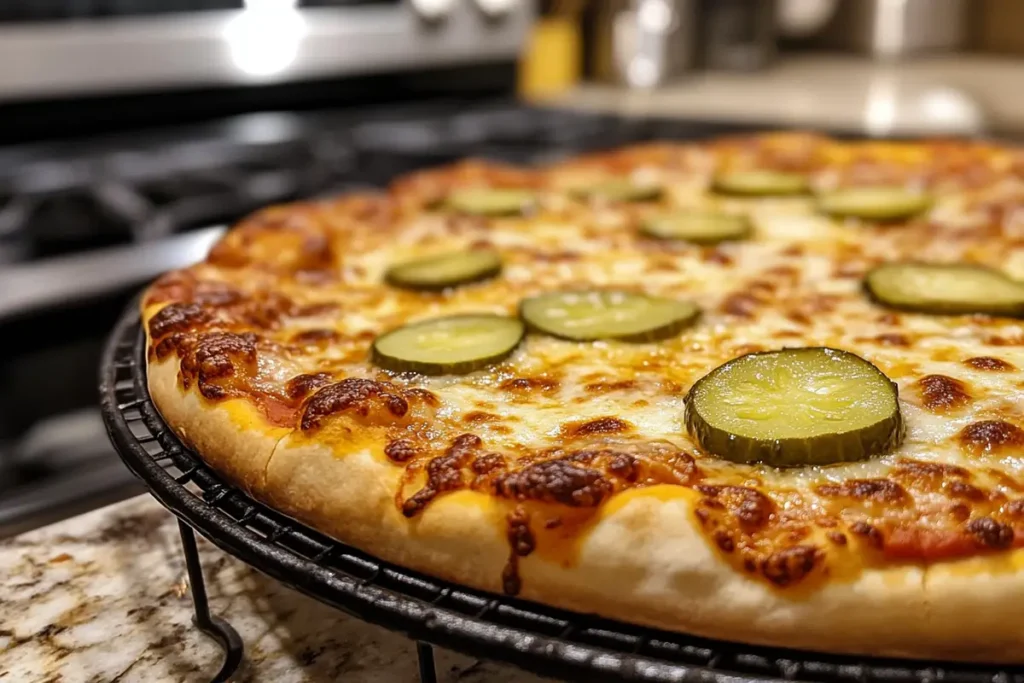
Ingredients Needed for Pickle Pie Pizza
A masterpiece starts with the right materials, and when it comes to crafting the perfect pickle pie pizza, every ingredient contributes to its flavor symphony. Whether you’re opting for homemade or store-bought elements, this section has you covered.
Dough Options
The dough is the unsung hero of any pizza. It must balance texture and flavor while supporting the toppings.
Homemade Thin Crust
Making your crust at home ensures you control the texture and taste. Combine basic ingredients like all-purpose flour, yeast, warm water, olive oil, and a pinch of sugar to activate the yeast. Once kneaded and rested, roll it thin for that classic crispy bite, ideal for enhancing the crunch of pickles.
Store-Bought Alternatives
Pressed for time? Many grocery stores offer ready-made pizza dough or crusts. Look for high-quality, thin crusts to complement the boldness of tangy pickles and creamy cheese. They’re a convenient option for a quick pizza night without compromising on flavor.
Sauce Varieties
The sauce is the flavor base of the pizza, uniting the crust and toppings in harmony.
Garlic Sauce
A rich, creamy garlic sauce elevates the pizza’s profile. Made by sautéing garlic in butter, then whisking in cream and a dash of salt, this sauce pairs beautifully with the sharpness of dill pickles. Its savory notes balance out the tang.
Ranch Dressing
For a slightly tangier and herbaceous twist, ranch dressing is a fantastic choice. Its smooth, creamy texture blends well with melted cheese and the crunch of thinly sliced pickles.
Cheese Selection
Cheese adds creaminess and richness, binding everything together. Choosing the right type can make or break your pizza.
Mozzarella
Mozzarella is the go-to for its mild flavor and unmatched stretchiness when melted. It creates the perfect base layer for pickles and ensures that each bite is as satisfying as the last.
Parmesan and Other Cheeses
For an added depth of flavor, sprinkle freshly grated Parmesan over the mozzarella. Or, experiment with other cheeses like Gouda for a smoky touch or cheddar for a sharper kick. Combining cheeses can unlock unexpected layers of flavor.
Step-by-Step Preparation Guide
Crafting pickle pie pizza might sound fancy, but it’s surprisingly straightforward. Follow this step-by-step guide to make a pizza that’s restaurant-quality right in your kitchen.
Preparing the Dough
If you’ve opted for homemade dough, start by rolling it out on a lightly floured surface to about 1/8-inch thickness for a crispy, thin crust. Preheat your oven to 400°F, and bake the rolled-out dough for 5–7 minutes until lightly golden. Pre-baking helps prevent the dough from becoming soggy once the toppings are added.
Making the Sauce
Prepare your chosen sauce while the crust is in the oven. For garlic sauce, sauté minced garlic in butter until fragrant, stir in heavy cream, and let it simmer until it thickens. If ranch dressing is your choice, use it as-is or thin it slightly with milk for easier spreading.
Assembling the Pizza
Remove the pre-baked crust from the oven and spread the sauce evenly across its surface, leaving a small border for the crust. Next, add a generous layer of mozzarella cheese, then carefully arrange thin slices of dill pickles in a circular pattern. For a gourmet finish, sprinkle Parmesan or Gouda over the top.
Baking Instructions
Increase your oven temperature to 425°F. Bake the pizza for 10–15 minutes or until the crust turns a golden brown and the cheese bubbles beautifully. Rotate the pizza halfway through baking to ensure even cooking.
Serving Suggestions
Once baked, let the pizza cool slightly before slicing—it’ll make cutting easier and prevent the cheese from sliding off. Garnish with fresh dill or crushed red pepper flakes for an extra burst of flavor. Pair it with creamy dipping sauces like ranch or garlic aioli for a truly indulgent experience.
Variations and Pairings
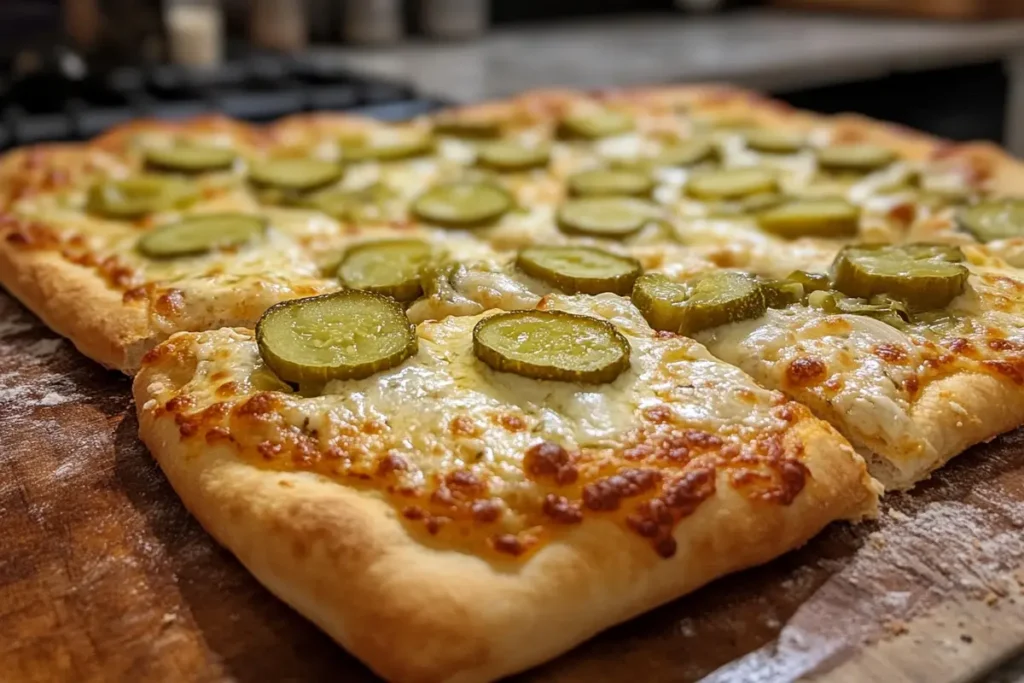
Creative Variations of Pickle Pie Pizza
Pickle pie pizza is already a bold, unique dish, but with a little creativity, you can make it your own. Whether you want to add proteins, experiment with different sauces, or cater to vegetarian preferences, the possibilities are endless.
Adding Proteins
For those looking to add a hearty element to their pickle pizza, proteins make an excellent addition.
Bacon
While bacon isn’t included in all recipes, crispy, smoky bits can balance the tanginess of pickles beautifully. Simply sprinkle pre-cooked, crumbled bacon over the cheese before baking to create a savory layer.
Ham or Canadian Bacon
For a slightly sweeter, meatier touch, add thinly sliced ham or Canadian bacon. These pair wonderfully with the briny flavor of dill pickles and add a rich texture to every bite.
Alternative Sauces
Switching up the sauce can completely transform the flavor profile of pickle pie pizza.
Spicy Mustard Sauce
If you’re feeling adventurous, try a spicy mustard sauce. Its bold, zesty flavor adds depth while complementing the acidity of the pickles. Whisk together Dijon mustard, a splash of honey, and a pinch of cayenne for a fiery twist.
Alfredo Sauce
For a creamier base, Alfredo sauce is a fantastic option. Its smooth, buttery texture works well with the crunch of pickles, creating a luxurious flavor combination.
Cheese Combinations
Cheese is where you can really let your creativity shine.
Cheddar and Gouda
A mix of sharp cheddar and smoky Gouda takes pickle pie pizza to another level. The cheddar adds a tangy punch, while the Gouda provides a velvety richness.
Feta and Blue Cheese
For a gourmet approach, sprinkle crumbled feta or blue cheese on top. Their bold flavors contrast nicely with the pickles, adding a sophisticated edge to the dish.
Vegetarian Options
Vegetarian twists on pickle pie pizza allow for fresh, vibrant flavors.
Adding Vegetables
Enhance the pizza with toppings like sliced cherry tomatoes, red onions, or even jalapeños for a spicy kick. These vegetables complement the tanginess of the pickles while adding color and texture.
Vegan Cheese Alternatives
For a vegan-friendly version, swap out dairy cheese for vegan cheese alternatives like cashew-based mozzarella or almond ricotta. Many brands offer plant-based cheeses that melt beautifully.
Ideal Pairings with Pickle Pie Pizza
Pairing the right sides and desserts with your pickle pie pizza can elevate your dining experience. Here are some delicious ideas to round out your meal.
Side Dishes
Side dishes bring balance to your pickle pie pizza feast.
Salads
A crisp side salad with mixed greens, cucumbers, and a light vinaigrette is a refreshing complement to the pizza’s bold flavors.
Dipping Sauces
For added indulgence, serve your pizza with dipping sauces like creamy ranch or garlic aioli. These dips enhance the pizza’s tanginess while providing extra richness.
Desserts
Finish your meal with something sweet to contrast the savory flavors of the pizza.
Light Sorbets
A fruit-based sorbet, like lemon or raspberry, cleanses the palate with its refreshing, tangy sweetness.
Fruit Platters
Opt for a colorful fruit platter featuring grapes, melons, and berries. The natural sweetness of the fruits balances the tangy, salty elements of the pizza.
Nutritional Information and Dietary Considerations
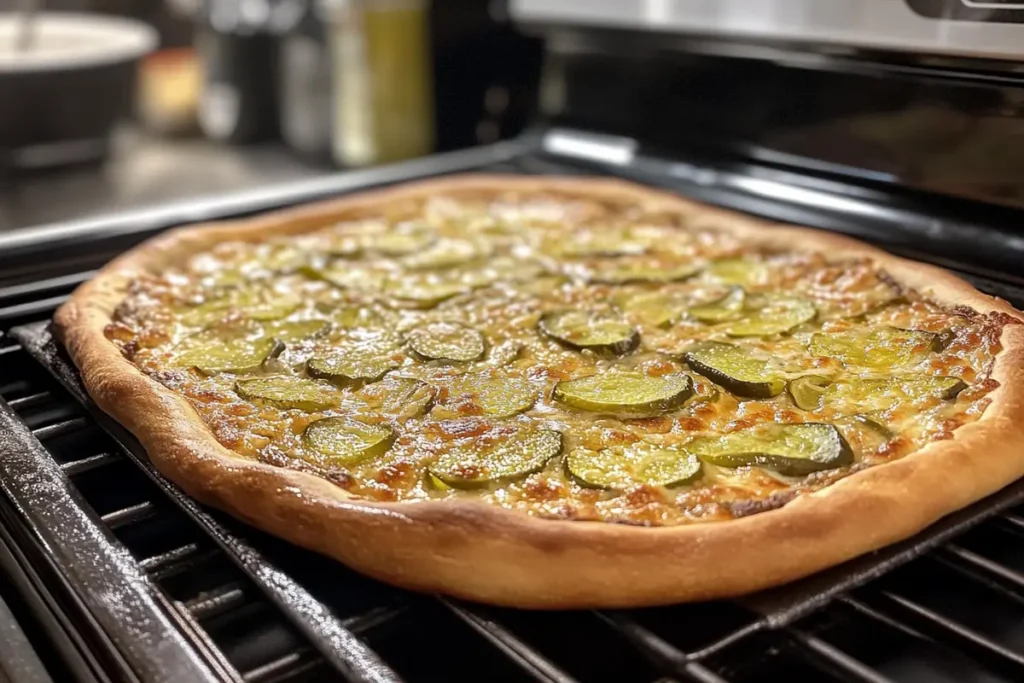
Nutritional Breakdown of Pickle Pie Pizza
Understanding the nutritional aspects of pickle pie pizza can help you enjoy this unique dish while keeping your dietary goals in mind. From calories to sodium, let’s take a closer look at what’s on your plate.
Caloric Content
Pickle pie pizza is a moderately caloric dish, with each slice averaging 250–300 calories depending on the crust, sauce, and toppings used. Opting for a thin crust and lighter cheese portions can reduce the calorie count, making it a more diet-friendly option. Homemade versions often have fewer calories compared to store-bought or restaurant-made pizzas.
Macronutrient Distribution
This pizza typically offers a balanced macronutrient profile. The crust provides carbohydrates for energy, the cheese contributes protein and fats, and the pickles add fiber and minimal calories. For those watching their protein intake, adding extra cheese or plant-based proteins can increase this macronutrient without significantly altering the flavor.
Sodium Levels
As delicious as pickles are, they come with a high sodium content. Depending on the type of pickles and cheese used, a single slice of pickle pie pizza can contain 400–600 mg of sodium. To reduce sodium levels, consider low-sodium pickles, homemade dough, or reduced-sodium cheeses. Moderation is key!
Adapting the Recipe for Dietary Needs
Pickle pie pizza can be customized to fit various dietary preferences and restrictions. Here’s how you can tweak the recipe without compromising on taste.
Gluten-Free Options
For those with gluten intolerance or celiac disease, replace the traditional crust with a gluten-free alternative. Many stores sell pre-made gluten-free pizza doughs, or you can make your own using almond or rice flour. Remember to check sauces for hidden gluten as well!
Low-Sodium Alternatives
Reducing sodium doesn’t mean sacrificing flavor. Opt for low-sodium pickles and cheeses, and use a lighter hand when seasoning your sauce. You can also make your own pickles to control the salt content. Fresh herbs like dill and basil can provide flavor without added salt.
Vegan Adaptations
Creating a vegan version of pickle pie pizza is easier than ever. Use plant-based cheeses like cashew mozzarella or almond ricotta, and select vegan-friendly sauces such as dairy-free garlic or ranch dressing. Pair with a vegan-friendly crust to enjoy this dish guilt-free.
Frequently Asked Questions (FAQs) about Pickle Pie Pizza
Can I use different types of pickles?
Absolutely! While dill pickles are the most common choice for pickle pie pizza, you can experiment with a variety of pickles to suit your taste. Sweet pickles bring a hint of sugary contrast, while spicy pickles add a fiery kick. Bread-and-butter pickles create a more mellow flavor, perfect for those who prefer less tanginess. If you’re adventurous, try pickled jalapeños or pickled vegetables like onions and carrots to mix things up.
How do I store leftover pickle pie pizza?
Leftover pickle pie pizza can be stored easily to enjoy later. Place the slices in an airtight container or wrap them tightly with plastic wrap or aluminum foil. Store the pizza in the refrigerator, where it will stay fresh for up to three days. When reheating, use an oven or toaster oven at 375°F for 5–10 minutes to maintain the crispy crust and melty cheese. Microwaving works in a pinch, but it may make the crust soggy.
Can I freeze pickle pie pizza?
Yes, pickle pie pizza can be frozen for future enjoyment. To freeze, allow the pizza to cool completely before wrapping individual slices tightly in plastic wrap and then placing them in a freezer-safe bag or container. Frozen slices can last up to two months. When ready to eat, thaw the slices in the refrigerator overnight, then reheat in the oven or toaster oven for the best texture and flavor.
What other toppings go well with pickles on pizza?
Pickles pair well with a variety of toppings that enhance their tangy flavor. For a savory balance, try sliced red onions, roasted garlic, or mushrooms. Vegetables like bell peppers and cherry tomatoes add a fresh, colorful touch. Cheese lovers can experiment with bold flavors like blue cheese or smoked Gouda. If you’re looking for spice, jalapeños or crushed red pepper flakes are excellent options to elevate the heat.
Conclusion
Recap of Key Points
Pickle pie pizza is a fun, creative twist on traditional pizza, featuring the tangy crunch of pickles paired with creamy sauces, gooey cheeses, and a crispy crust. Whether you’re making it from scratch, adding unique toppings, or adapting it to fit your dietary needs, this dish offers endless possibilities for customization.
Encouragement to Try the Recipe
If you’re a pickle enthusiast or just someone who loves trying new flavors, pickle pie pizza is a must-try. It’s a delightful mix of bold and comforting flavors that’s sure to impress family and friends. So why wait? Gather your ingredients, roll out the dough, and create your own version of this unforgettable pizza today!

